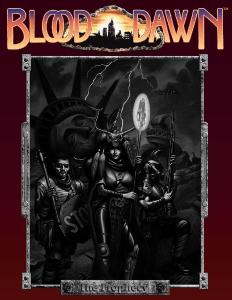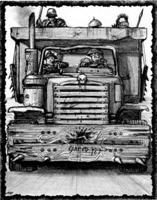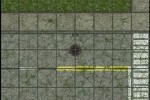
Product Name: Blood Dawn
Publisher: SSDC
Author: Lawrence R. Sims
System: Blood Dawn
Setting:
Series:
Theme: Sci-Fi Fantasy Post-Apocalyptic
Type: Core Rulebook (2nd Edition)
Link: http://www.ssdc.com/
Blood Dawn is a Sci-Fi Fantasy Post-Apocalyptic game system originally published in 1996. It carries many different aspects of the post-apocalyptic theme including survival and rebellion, depending on what type of game the players and GM are trying to create. It takes place after a nuclear World War III where the majority of the world has been turned into a wasteland and society is drastically segregated. The game utilizes a roll-under d20 system based upon a character’s given skill level and the task’s difficulty level.
The players take the part of freedom fighters, referred to as Prophets, for the purpose of over-throwing (or at least persuading) the new government to create an equal society where all humans and non-humans (a by-product of World War III) can live together. These Prophets are lead by a secret underground society, known as the Underground Collective, and given special cybernetic enhancements to help them along their way. However, after they are brought into the Underground Collective and given their abilities, they are primarily “thrown to the wolves” and forced to fend for themselves throughout the course of their career. Blood Dawn is filled with twists and turns and an almost humorous look at the world after Armageddon.
INTRODUCTION

The introduction is broken down into four different chapters: story, background, system introduction, player character introduction. The first chapter is a narrative called The Big Score. This story represents a group of Prophets, known as a Cabal, as they venture across the land and the troubles they face. The narrative shows a great combination of combat and non-combat encounters and represents a possible game session.
The background retells the history of what lead to Armageddon and some of the events that have lead up to the systems date including a full time-line of these events. In Blood Dawn, the majority of regular humans have banded together to live their life away from those who are struggling to survive within the wasteland that remains outside of their domed cities.
The system introduction is a basic overview of the Blood Dawn system and an explanation of terminology used throughout.
Player character introduction is a very important introduction as it explains to the players why their PCs are doing what they are doing. It is the goal of the Underground Collective to set balance to a world that was all but destroyed.
CHARACTER GENERATION
Character generation is done quite simply: Purchase stats, purchase skills, and choose a race (from a list of 7 – Albino Giants, Druids, Ghouls, Healers, Humans, Witches, and Mutants). This simple method of character generation allows players to create virtually any type of character imaginable, or players can choose to use one of the books sample archetypes. The basic concept is that the PC is a race but without a given class. Players are free to use their imagination on creating a multitude of character types using a fairly simple method. This is definitely one of Blood Dawn’s strongest mechanics.
SKILLS
Blood Dawn uses skill mechanics similar to that of Battlelords of the Twenty-Third Century. There is a small number of skill groups with each group containing multiple “specializations” to give the character some focus. The part that stands out the most is that when a skill is purchased, the character automatically gains it at 10 (considering it’s a d20 system) plus 1 for each level of proficiency. This creates a sense that characters are actually trained in that skill with stats that back-up that idea.
Each skill group is listed in a table with its proficiencies along with detailed descriptions following the tables.
RULES AND MAGIC

The rules chapter fully explains the core mechanics of the system and gives lots of great examples. There are some devastating mechanics for combat and critical hits. Players should be wise to tread lightly when it comes to engaging in combat. Being that Blood Dawn is Post-Apocalyptic, a common theme to find is vehicle combat. There are numerous mechanics to deal with vehicle combat almost as if the vehicle was another character with standard attack moves.
The rules for magic are quite standard for fantasy-themed systems (even Post-Apocalyptic) with spells that fall into 1 of 12 different types. Mage-types are not quite as flexible as general Character Generation, but there are at least enough types to keep characters somewhat unique. Subsequent sourcebooks can easily add more as the magic system is very simple.
EQUIPMENT
Blood Dawn includes a vast equipment list including weapons, armor, vehicle parts, books, food, and even furniture. As this is Post-Apocalyptic, one should never take the simplest item for granted as it could be used as a bargaining tool later on. Each piece of equipment is further explained with a detailed description. Included in this section is also a vast collection of different vehicles to coincide with those great mechanics for vehicle combat.
SETTING AND SYSTEM
The description of the setting and the included system tips for the GM really give a good perspective of how life is within the Blood Dawn setting. These two sections take a 360-degree look at life in virtually every nook-and-cranny of the world as it now exists. This is quite the range of different landscapes from the domed cities and those they employ to the vicious shanty towns filled with different races and groups all trying to survive life within the wasteland.
APPENDIX
The appendix is a little creepy. There is a table that shows the major metropolitan areas in the US and the destruction they received at the hands of the nuclear warheads. An absolute must for the GM!
OVERALL
Blood Dawn is definitely an interesting game system filled with lots of potential. One of my favorite parts is how PCs view the tangible items we possess in a world post-Armageddon. For instance, what is a computer? Or what is a camera? This type of perception, or rather a lack of, allows for hours and hours of fun role-playing experiences with plenty of opportunities to shoot down the bad guys or help out a starving shanty town.
RATINGS
Publication Quality: 6 out of 10
I’m slightly divided on how I view Blood Dawn’s publication quality. The layout and presentation are great while the illustrations look fantastic, but the sections of the book that appear as though they were created from scanned copies, or at least did not render properly, really detract from the overall quality. I also found a lack of overall consistency with the formatting in certain sections that adds to this reduction in quality. While the overall publication reads smoothly and looks good, these areas of low-quality reduce the overall visual appeal.
Mechanics: 8 out of 10
Blood Dawn carries some similar mechanics to Battlelords of the Twenty-Third Century, but in general it is a unique system of its own. I like the implementation of the skills in regards to performing skill checks and the overall feel of the system should lend itself quite well to both Post-Apocalyptic Survival and Rebellion. However, the mechanics for armor (similar to that of Battlelords) may play-out a bit clunky within Blood Dawn if it causes game-play to slow down. As this is not a Military Sci-Fi system, I do not find it necessary to have such in-depth mechanics for armor (especially when most of the armor is makeshift anyway). Regardless of the armor mechanics, I like the roll-under d20 system and the ease at which skill checks can be performed successfully. What really makes the system shine, mechanics-wise, is the ability to create virtually any type of character possible. This inherent flexibility allows players to be more creative on how they view their PCs characteristics and how they would perceive life post-Armageddon. The vehicle mechanics also great enhance the system and could make for some very interesting game sessions.
Desire to Play: 7 out of 10
Blood Dawn has a great storyline and I like how it doesn’t solely focus on survival-based Post-Apocalyptic. This allows players to create different types of game-play experiences considering the mood they may be in at that time. Combat seems a bit lethal and the content does boast that non-combat-focused skills are often more important than combat ones. This could be because of how easy it may be to die or possibly how much of struggle it is to simply survive. Regardless of the reasoning, players are bound to be put to the test within Blood Dawn.
Overall: 7 out of 10
Blood Dawn offers a lot of flexibility for Post-Apocalyptic. This includes the different “races” the players can choose along with the flexibility of simply creating any type of characters using the different skills provided. This opens the game to a wide range of player interests that can range from the treacherous Witch to the skillful Sniper and even the intelligent Investigator. It’s almost as if the system takes several archetypes from the different genres, mashes them together, and mixes them up for everyone to use. It’s bound to create many great gaming sessions and, if you survive, and epic finish to a lengthy campaign.

